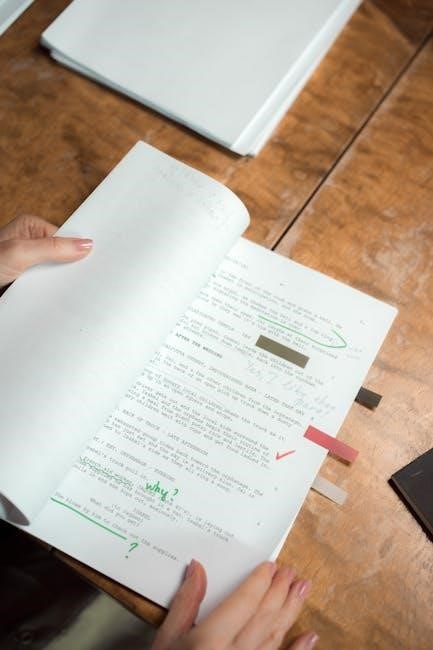
the study of orchestration 4th edition pdf
Overview of the Book
The 4th Edition of The Study of Orchestration by Samuel Adler is a comprehensive guide to orchestral composition, offering insights into instrument characteristics, textures, and historical developments. It combines practical exercises with multimedia resources, making it indispensable for both students and professionals in music composition and orchestration.
The Study of Orchestration, 4th Edition, authored by Samuel Adler, serves as a foundational guide for understanding orchestral composition. It delves into the characteristics of orchestral instruments, exploring their unique timbres, ranges, and technical capabilities. The book also examines the evolution of orchestration techniques, tracing historical developments and their impact on modern practices. Adler’s approach emphasizes both practical and aesthetic aspects, providing students with a holistic understanding of how to effectively arrange and compose for orchestral ensembles. The 4th Edition enhances learning with integrated audio and video resources, allowing readers to hear and visualize orchestral concepts in action. This comprehensive approach makes the text invaluable for students, composers, and musicians seeking to master the art of orchestration.
Importance of Orchestration in Music Composition
Orchestration is the backbone of music composition, transforming musical ideas into vivid, layered soundscapes. It involves assigning roles to instruments, balancing timbres, and creating harmonic textures that resonate emotionally. By understanding the unique qualities of each instrument, composers can craft compositions that are both technically precise and artistically compelling. Orchestration bridges the gap between a composer’s vision and its auditory realization, ensuring that the music conveys the intended mood and complexity. This process not only enhances the listener’s experience but also elevates the composer’s ability to express intricate musical narratives. Thus, orchestration is essential for creating rich, dynamic, and impactful musical works.
Target Audience and Purpose
The Study of Orchestration 4th Edition is tailored for music students, composers, and professionals seeking to refine their orchestration skills. It serves as a practical guide for understanding instrument characteristics, textures, and historical practices. The book is designed to aid students in developing orchestration techniques through exercises, worksheets, and multimedia resources. Professionals benefit from its in-depth analysis of orchestral works and insights into modern compositional practices. The purpose of the text is to provide a comprehensive toolkit for mastering orchestration, bridging theoretical knowledge with practical application. By focusing on both traditional and contemporary methods, it equips readers to create dynamic and expressive musical compositions.

Author Background
Samuel Adler, a renowned composer and educator, brings extensive experience in orchestration. His works, performed globally, establish his authority in the field, making him an ideal author for this text.
Samuel Adler: Biography and Contributions to Music
Samuel Adler, born in 1928, is a distinguished American composer and conductor. His contributions to music education are profound, particularly through The Study of Orchestration, which has become a cornerstone in music education. Adler’s compositions span symphonic works, chamber music, and operas, performed by major orchestras worldwide. His expertise in orchestration stems from a deep understanding of instrumental technique and historical context. Adler’s approach emphasizes both the practical and aesthetic aspects of orchestration, blending tradition with innovation. His work has shaped generations of composers and musicians, solidifying his legacy as a master educator and composer.
Adler’s Approach to Orchestration
Samuel Adler’s approach to orchestration is both methodical and creative, emphasizing the practical and aesthetic aspects of instrumental composition. His teaching methodology focuses on understanding the unique characteristics of each instrument, exploring their technical capabilities, and demonstrating how to combine them effectively. Adler’s approach bridges tradition and innovation, drawing on historical practices while incorporating modern techniques. He advocates for clarity, balance, and emotional impact in orchestral writing. The 4th Edition of his book introduces multimedia resources, allowing students to hear and analyze orchestral excerpts, reinforcing theoretical concepts with real-world examples. Adler’s systematic yet artistic approach has made his text a benchmark for orchestration studies, inspiring composers to master the craft of instrumental writing.
Reception of His Work in the Musical Community
Samuel Adler’s The Study of Orchestration has been widely acclaimed as a definitive text in music education. The 4th Edition has received praise for its comprehensive approach, blending theoretical insights with practical applications. Adler’s work is celebrated for its clarity and accessibility, making it a favorite among students and professionals alike. The integration of audio and video resources has been particularly well-received, offering a modern and immersive learning experience. The musical community recognizes Adler’s contributions as a composer and educator, and his book continues to set standards in orchestration studies. Its enduring popularity underscores its relevance and value in both academic and professional settings.

Structure of the 4th Edition
The 4th Edition of The Study of Orchestration features a comprehensive structure, with multimedia resources, exercises, and case studies, organizing content logically from foundational concepts to advanced techniques.

Key Features of the 4th Edition
The 4th Edition of The Study of Orchestration offers enhanced multimedia resources, including online audio and video recordings, allowing students to hear orchestral instruments in context. It provides comprehensive exercises and worksheets for practical skill development, ensuring hands-on learning. The edition also includes detailed case studies of renowned orchestral works, offering insights into masterful composition techniques. Additionally, it integrates computer-assisted analysis tools, enabling students to explore orchestration digitally. These features, combined with Adler’s expert guidance, make the 4th Edition a robust and modern resource for understanding orchestration principles and practices.
Organization of Chapters and Topics
The Study of Orchestration 4th Edition is meticulously organized to guide students through the fundamentals and advanced techniques of orchestration. The book begins with an introduction to orchestral instruments, exploring their unique characteristics and roles. Subsequent chapters delve into texture, balance, and blend, providing practical insights into creating cohesive orchestral soundscapes. Historical developments in orchestration are traced, highlighting key composers and their contributions. The text also includes sections on transcription, arrangement, and case studies of iconic works, offering real-world applications of orchestration principles. Each chapter builds logically on the previous one, ensuring a comprehensive and structured learning experience for students of music composition and orchestration.
Integration of Audio and Video Resources
The 4th Edition of The Study of Orchestration enhances learning through the integration of audio and video resources. These multimedia elements allow students to hear and see orchestral instruments in action, providing a deeper understanding of their sonic qualities and performance techniques. The included online recordings and videos demonstrate various orchestral passages, enabling students to analyze how different instruments and sections contribute to the overall composition. This multisensory approach bridges theory and practice, making complex orchestration concepts more accessible and engaging. The resources also include examples of historical and contemporary orchestral works, offering a rich contextual framework for study and inspiration.

Core Concepts in Orchestration
The book explores fundamental principles of orchestration, including instrument characteristics, texture, and balance. It emphasizes understanding each instrument’s unique qualities and their role within the ensemble, providing a comprehensive foundation for composers to create effective and expressive orchestral works.
Characteristics of Orchestral Instruments
The 4th edition of The Study of Orchestration provides an in-depth exploration of the unique qualities of orchestral instruments, including their range, tone, and technical capabilities. Adler emphasizes understanding each instrument’s distinct voice, from the brightness of brass to the warmth of strings. Practical examples and exercises help students apply this knowledge in composition. The book also discusses how instrument characteristics influence orchestration decisions, such as balance and blend. By mastering these principles, composers can effectively utilize the orchestra’s diverse palette to create rich and dynamic musical textures. This section is essential for building a strong foundation in orchestration techniques.
Texture and Its Role in Orchestration
Texture, a fundamental element in orchestration, refers to the layering of melodies and harmonies within a composition. The Study of Orchestration explores how texture shapes musical form and expression. Adler examines various textures—monophony, polyphony, homophony, and heterophony—demonstrating their impact on orchestral writing. He emphasizes the importance of balance and contrast in textures to create dynamic and engaging music. Practical examples and analyses illustrate how master composers achieve texture through instrumentation and arrangement. This section provides students with tools to manipulate texture effectively, enhancing their orchestration skills and artistic expression. Understanding texture is crucial for crafting cohesive and impactful orchestral works.
Balance and Blend in Orchestral Writing
Balance and blend are critical in orchestral writing to ensure clarity and coherence. Adler discusses how to achieve balance by distributing musical material across instrumental sections, preventing overload or weakness. Blend refers to the seamless integration of diverse timbres, creating a unified sound. The book provides practical strategies for balancing dynamics, registers, and textures while maintaining optimal blend. Adler illustrates these concepts with examples from masterworks, demonstrating how composers achieve balance and blend through thoughtful orchestration. This section equips students with techniques to craft polished, professional-sounding scores, emphasizing the importance of these elements in creating impactful orchestral music.

Historical Development of Orchestration
The evolution of orchestration traces the expansion of instrumental ensembles, from Baroque chamber groups to the large symphonic orchestras of the Romantic era, reflecting compositional innovation and instrumental advancements over centuries.
Evolution of Orchestral Instruments Over Time
The evolution of orchestral instruments over time is a fascinating journey marked by technological advancements and compositional demands. From the Baroque period’s limited ensembles to the expansive Romantic orchestras, instruments underwent significant transformations. The development of valves in brass instruments and the refinement of string construction enabled greater expressivity and range. Over three centuries, composers like Haydn, Beethoven, and Berlioz pushed instrumental boundaries, incorporating new timbres and textures. Analyzing 180 orchestral works from 1701 to 2000 reveals shifts in instrumentation, with increases in ensemble size and diversity. These changes reflect both stylistic evolution and the innovative spirit of composers, shaping the modern orchestra’s versatility and richness.
Changes in Instrumentation and Compositional Practices
Changes in instrumentation and compositional practices over three centuries reveal a dynamic interplay between technical advancements and artistic expression. Empirical analyses of 180 orchestral works from 1701 to 2000 highlight shifts in instrument usage, ensemble size, and common combinations. The integration of new instruments and timbres, such as the tuba and contrabassoon, expanded orchestral palettes. Composers like Beethoven and Berlioz pioneered innovative scoring techniques, while later composers incorporated diverse instrumental textures. These changes reflect evolving aesthetic preferences, from the clarity of Classical music to the richness of Romantic orchestration. The study also notes associations between specific instruments and dynamics, tempos, and harmonic structures, offering insights into how composers adapted their practices to emerging musical styles and instrumental capabilities.
Key Composers and Their Contributions to Orchestration
Key composers have significantly shaped orchestration through their innovative techniques and mastery of instrumental textures. Beethoven expanded orchestral size and dynamic range, while Berlioz introduced bold, colorful scoring in works like Symphonie Fantastique. Wagner’s operas revolutionized orchestration with rich, complex harmonies and timbres. Strauss perfected the art of orchestration, showcasing virtuosic writing in tone poems like Don Juan. These composers, along with others like Mozart, Haydn, and Mahler, laid the foundation for modern orchestration, demonstrating how instrumental choices and textures could evoke powerful emotions and narratives. Their contributions remain central to the study and practice of orchestration, as explored in Adler’s comprehensive analysis.

Practical Applications of the Book
The 4th Edition offers exercises, worksheets, and case studies to develop orchestration skills. It provides guidelines for transcribing and arranging music, enhancing practical understanding and application of orchestral techniques.
Exercises and Worksheets for Skill Development
The 4th Edition includes a variety of exercises and worksheets designed to help students master orchestration techniques. These exercises focus on specific skills, such as clef writing, bowing techniques, and string harmonics, ensuring a deep understanding of orchestral practices. Additionally, transcription exercises allow students to practice arranging music for different ensembles, reinforcing their ability to adapt compositions. The worksheets provide structured tasks that guide learners through complex concepts, making the learning process both engaging and effective. By completing these exercises, students can apply theoretical knowledge to real-world scenarios, developing the practical skills necessary for orchestration. This hands-on approach ensures a comprehensive mastery of the subject.
Guidelines for Transcribing and Arranging Music
The 4th Edition provides detailed guidelines for transcribing and arranging music, emphasizing the importance of understanding the original composition’s intent and structure. Students are encouraged to analyze scores meticulously before adapting them for different ensembles. The book offers a step-by-step approach, from selecting appropriate instruments to balancing timbres and dynamics. Practical considerations, such as instrumental range and technical limitations, are highlighted to ensure arrangements remain faithful to the original while being idiomatic for the target ensemble. These guidelines equip students with the skills to create effective and artistically coherent transcriptions, bridging the gap between theoretical knowledge and practical application in orchestration.
Case Studies of Orchestral Works
The 4th Edition includes in-depth case studies of orchestral works, offering analyses of compositions by renowned composers like Samuel Adler, Haydn, and Mozart. These studies explore how master composers approach orchestration, focusing on techniques such as texture, balance, and instrumental color. Specific works, such as Adler’s Symphonie Dramatique and Piano Concerto No. 2, are dissected to reveal their orchestral strategies. These case studies provide practical insights into historical and contemporary orchestration practices, allowing students to learn from real-world examples. By examining these works, students gain a deeper understanding of how orchestration contributes to the overall musical structure and emotional impact, making these case studies invaluable for developing their compositional skills.

Technological Integration
The 4th Edition integrates digital tools, offering online audio/video resources and computer-assisted analysis to enhance orchestration study. Software aids in creating and refining compositions, bridging tradition with modern technology.
Use of Digital Tools in Modern Orchestration
Digital tools have revolutionized modern orchestration, enabling composers to explore new sonic possibilities. Software like notation programs and DAWs (Digital Audio Workstations) streamlines the creation and editing of scores. Virtual instruments and sample libraries provide realistic representations of orchestral sounds, allowing for precise arrangement and testing without a live ensemble. These tools also facilitate collaboration and experimentation, making the orchestration process more efficient. The 4th Edition of The Study of Orchestration incorporates such technologies, offering interactive resources that enhance learning and application. By integrating digital tools, the book bridges traditional orchestration techniques with contemporary practices, ensuring students are well-equipped for modern musical demands.
Computer-Assisted Analysis of Orchestration

Computer-assisted analysis of orchestration provides a detailed examination of musical structures and textures. By employing numerical representations and hierarchical frameworks, this method assesses heterogeneity, diversity, and complexity in orchestral configurations. It enables composers to identify patterns and relationships between instruments, dynamics, and tempos. The 4th Edition of The Study of Orchestration incorporates such analytical tools, offering insights into historical trends and compositional practices. These resources allow students to explore how orchestration evolves over time and how different composers utilize instrumental textures. This approach not only enhances understanding but also equips musicians with practical skills for creating and analyzing orchestral works effectively.
Role of Software in Orchestral Composition
Software plays a pivotal role in modern orchestral composition by providing tools for notation, playback, and analysis. Programs like notation software enable precise score creation, while virtual instruments and digital audio workstations (DAWs) allow composers to experiment with sounds and textures. The 4th Edition of The Study of Orchestration integrates access to digital resources, enhancing the learning experience. These tools facilitate real-time feedback, enabling composers to refine their work dynamically. Additionally, software aids in analyzing orchestral-textural configurations, offering insights into historical and contemporary practices. This technological integration bridges theory and practice, making orchestration more accessible and innovative for both educators and students in music composition.

Reception and Reviews
The Study of Orchestration 4th Edition is widely praised for its comprehensive approach, earning acclaim from both academic circles and professional musicians. Its detailed insights and practical exercises make it a cornerstone in music education, solidifying its reputation as an indispensable resource for composers and students alike.
Academic and Professional Reviews of the 4th Edition
The Study of Orchestration 4th Edition has received widespread acclaim for its thorough exploration of orchestral techniques and instrument characteristics. Academics praise its clarity and depth, while professionals appreciate its practical insights. Many reviewers highlight the book’s ability to bridge theory and practice, making it invaluable for both students and seasoned composers. The inclusion of multimedia resources in this edition has been particularly well-received, offering a hands-on learning experience. The text is commended for its holistic approach, covering historical context, modern applications, and innovative exercises. Its reputation as a leading orchestration text continues to grow, solidifying its place as a cornerstone in music education and professional development.
Student Feedback and Learning Outcomes
Students have praised the 4th Edition of The Study of Orchestration for its comprehensive and accessible approach to learning orchestration. Many report improved understanding of instrumental characteristics and compositional techniques. The inclusion of hands-on exercises and multimedia resources has been particularly appreciated, as they enhance practical skill development. Feedback highlights the book’s ability to cater to both beginners and advanced learners, with clear explanations and real-world examples. The structured format and logical progression of topics have been credited with fostering deeper engagement and mastery. Overall, the text has proven effective in helping students achieve proficiency in orchestration, preparing them for careers in music composition and arrangement.
Comparison with Previous Editions
The 4th Edition of The Study of Orchestration builds upon the success of earlier versions, offering significant enhancements. It includes expanded chapters on modern orchestration techniques, additional exercises for practical application, and updated multimedia resources. Compared to previous editions, the 4th Edition provides greater clarity in explaining complex concepts, such as texture and balance, and incorporates more contemporary examples. The integration of audio and video resources is a notable improvement, allowing students to engage with orchestral works in a more immersive way. Overall, this edition refines the content while maintaining the book’s reputation as a foundational resource for orchestration studies, ensuring it remains relevant for today’s musicians and composers.
The Study of Orchestration, 4th Edition remains a cornerstone in music education, offering comprehensive insights into orchestral techniques and modern composition practices. Its enhanced multimedia resources and updated content ensure continued relevance for future generations of musicians and composers.
Impact of “The Study of Orchestration” on Music Education
The Study of Orchestration has profoundly shaped music education, serving as a foundational text for composers and students worldwide. Its detailed exploration of orchestral techniques and historical context provides a holistic understanding of music composition. The book’s practical exercises and multimedia resources enhance learning, making complex concepts accessible. By bridging theory and practice, it has influenced curriculum development in music programs globally. Its emphasis on instrument characteristics, texture, and balance has nurtured generations of composers, ensuring the continued evolution of orchestration. The integration of technology in the 4th Edition further solidifies its role in modern music education, making it an indispensable resource for both students and professionals.
Future Directions in Orchestration Studies
Future directions in orchestration studies will likely focus on integrating advanced technologies, such as AI and machine learning, to analyze and predict orchestral trends. Virtual and augmented reality tools could enhance composers’ ability to experiment with soundscapes. Empirical studies, like those analyzing historical instrument usage, will continue to provide insights into compositional practices. Interdisciplinary approaches, blending psychology and cognitive science, may explore how listeners perceive orchestration. Additionally, the rise of digital platforms will enable global collaboration, fostering diverse orchestral styles. These innovations will complement traditional methods, ensuring orchestration remains a vibrant and evolving field, bridging the gap between historical techniques and modern creative possibilities while maintaining its artistic core.
Final Thoughts on the 4th Edition
The 4th Edition of The Study of Orchestration solidifies its position as a landmark text in music education, offering a balanced blend of tradition and innovation. Its inclusion of audio and video resources provides practical tools for modern learners, while its detailed analysis of orchestral techniques remains unparalleled. Adler’s approach ensures accessibility for newcomers while offering depth for seasoned professionals. This edition not only honors the legacy of orchestration but also prepares students for future challenges in composition. Its comprehensive coverage, coupled with its emphasis on both historical and contemporary practices, makes it an indispensable resource for anyone seeking mastery in orchestral writing.